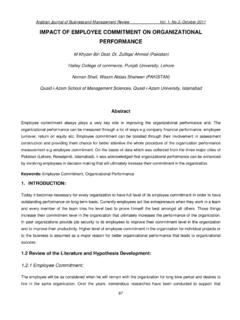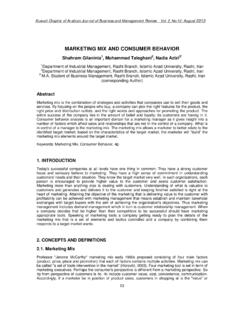Transcription of INVESTIGATION INTO THE CAUSES OF SMALL AND MEDIUM ...
1 2015 February; 7 Vol. 4, Journal of Business and Management Review ( oman chapter ) 80 INVESTIGATION into THE CAUSES OF SMALL AND MEDIUM ENTERPRISE FAILURES IN WINDHOEK, NAMIBIA Jonisiu Ndinomwene Kambwale Graduate of the Regent Business School, Durban, Republic of South Africa, Residing and Working in Namibia Clever Chisoro Academic and Dissertation Supervisor, Regent Business School, Durban, Republic of South Africa Anis Mahomed Karodia (PhD) Professor, Senior Academic and Researcher, Regent Business School, Durban, Republic of South Africa ABSTRACT This study sought to analyse the factors that contribute to the failure of SMALL and/or MEDIUM Enterprises (SMEs) in Windhoek, Namibia. The objectives of this study were to determine the CAUSES SME failures, to examine ways in which SME failures can be overcome, and to recommend ways in which SMEs can overcome their problems.
2 These aspects were done by identifying the CAUSES of SME failure, and were deemed important that the CAUSES of SME failure be understood. Through an analysis of literature information and primary findings, new, better and effective ways were established to help SMEs to overcome the problems experienced. The findings from the study indicated that there are many CAUSES of SME failure in Windhoek, Namibia. The study indicated that a lack of management skills, a lack of financial support and a lack of business training are the major CAUSES of SME failure in Windhoek. It is recommended that the Government of Republic of Namibia and SME owners, managers and supervisors help them avoid the failure of SMEs. Key Words: INVESTIGATION ; Failure; CAUSES ; SMALL and MEDIUM Enterprises; Analysis; Management Skills; Financial Support; Business Training; Managers; Supervisors INTRODUCTION In recent decades, Namibia has witnessed a phenomenal growth in the number of new businesses.
3 This is especially true when it comes to the operation of SMEs. Indeed, almost 40,000 SMEs are currently registered in Namibia. SMEs in Namibia contribute to the national economy of Namibia in various ways, such as employment creation, adding value to the gross domestic product of the country, and assisting in the realisation of the government s 2030 vision agenda. Concomitantly, it has also been observed that the majority of these businesses experience difficulties during the first twenty-four months of their existence, and, in most cases, before full establishment. Indeed, available data indicates that approximately 75% of the SMALL -scale businesses experience such difficulties in the first twenty-four months. It is equally pertinent to note that this increased failure rate is substantially greater than the increase in the rate of new business creations. This problem appears to be more prevalent among the SMALL -scale.
4 2015 February; 7 Vol. 4, Journal of Business and Management Review ( oman chapter ) 81 businesses that operate in Namibia in relation to the MEDIUM enterprises that operate in its economy. The growth of SMEs is a critical ingredient for the sustainable development of developing economies. This chapter focuses on the background of the problem, problem statement, aim of the study, objectives of the study, research question, significant of the study, the format of the study and the conclusion of the chapter . Background to the Problem Governments throughout the world attempt to promote economic progress by focusing on SMALL -scale enterprises. It has been argued that SMEs are the backbone of most economies and are a key source of economic growth, dynamism and flexibility. SMEs contribute to the development of an economy in various ways, including generating employment and providing services.
5 Namibia has witnessed a phenomenal growth in the number of business start-ups during the past two decades following the independence of Namibia. In fact, almost 40,000 SMEs are currently registered in Namibia. According to the Bank of Namibia Symposium (2010:31), SMEs in Namibia have contributed approximately 12% to the Gross Domestic Product (GDP), have employed about 20% of the workforce between 2004 and 2009, and are helping towards the realisation of the Namibian government s 2030 vision. Despite the fact that SMEs play an increasingly important role in providing new products and employment opportunities, SMEs in Namibia have encountered many difficulties, especially financing. SMEs frequently lack access to institutional credit, which CAUSES SMEs to encounter high financing costs and prospective failure. The economic, financial and social losses that result from these failures are significant.
6 It is equally pertinent to note that, consistently, this increased failure rate is substantially greater than the increase in the rate of new business creation. This problem appears to be more prevalent among the SMEs that operate in Namibia in relation to the larger enterprises that operate in its economy. Based on this, it seems that research is needed to determine the CAUSES of SMEs failure in Namibia. Objectives of the Study The objectives of the study are: To discover the CAUSES of SMALL and MEDIUM enterprise failures in Windhoek, Namibia. To determine the ways in which the failures of SMALL and MEDIUM enterprise can be overcome. To recommend ways in which SMALL and MEDIUM enterprises can implement strategies to avoid or reduce failure. LITERATURE REVIEW Introduction According to Dawidowicz (2010:6), a literature review is an examination of scholarly information and research-based information on a specific topic.
7 Its goal is to create a complete, accurate representation of the knowledge and research-based theory available on a topic. Saharan (2008:66-67) describes a literature review as a clear and logical presentation of the relevant research work done thus far in a particular area. The purpose of a literature review is to identify and highlight the important variables and to document the important findings from earlier research that will serve as the theoretical framework for the current INVESTIGATION and from which hypotheses can be developed. This chapter reviews the existing literature on factors that cause . 2015 February; 7 Vol. 4, Journal of Business and Management Review ( oman chapter ) 82 the failures of SMEs. The chapter covers the definition of SMEs and the importance of SMEs in the economy, the reasons for SME failure and the role of government and financial institutions in helping SMEs to access finance.
8 Definitions of SMEs Although countries around the world define SMEs differently, these definitions are similar. According to Uganda Bureau of Statistics (2008:5), an SME is a business that employs 5 to 50 people ( SMALL scale) and 51 to 500 people ( MEDIUM scale). This means that, in Uganda, SMEs are classified into categories of SMALL scale and MEDIUM scale businesses. However, in Botswana, SMEs are categorized into three groups. Nkwe (2012:30) states that more variables are used to determine SMEs, such as employment level, annual turnover and annual balance sheet total. He states that, currently, Botswana s accepted definition of SMEs is based on three categories of enterprises using the annual turnover and the number of employees. Similarly to Botswana, Namibia uses these categories to classify SMEs. According to the Namibia Institute of Public Policy Research (IPPR; 2010:5), the ministry of Trade and Industry in Namibia define SMEs as a sector of business organisations composed of SMALL business enterprises with full time employees ranging from 6 to 100 employees.
9 The Table , below, summarizes the definition of SMEs in the context of Namibia. It is apparent from that, in Namibia, the definition of an SME is based on the number of employees, annual sales turnover as well as the capital base of a business as the relevant criteria. Table : Criteria for Defining SMALL Businesses in Namibia Sector Employment Turnover Less than N$000 Capital Less than N$000 Manufacturing Less than 10 Persons 1000 500 All other Business Less than 5 Persons 250 100 Source: LaRRI and NEPRU (2008). The Importance of SMEs According to the former Motor Vehicle Accident (MVA) Namibia Chief Executive Officer Jerry Mwadinaohamba (2011:28), SMEs are important to almost all economies in the world, but especially in developing countries like Namibia with major income discrepancies between the rich and the poor and high unemployment. On the termed static front, SMEs contribute to output by participating in the mainstream economy and to the creation of some decent jobs, especially to those that own or manage SMEs.
10 All this information coupled together, SMEs are major employers and can close economic inequality between the rich and the poor. On the other hand, SMEs are a nursery for the larger firms of the future; many large firms started as SMEs before growth and development. It is, therefore, in this regard that SMEs are an important step for expanding micro enterprises as they contribute directly and often significantly to aggregate savings and the investment of any nation and are involved in the development of appropriate technology. In asking how important the SME sector is, it must of course go beyond simply looking at its share of output, employment or any other aggregate variable. Assessment should involve how much difference does it make to the overall economic performance whether the . 2015 February; 7 Vol. 4, Journal of Business and Management Review ( oman chapter ) 83 SME sector is large or SMALL , or whether it grows rapidly or slowly?








